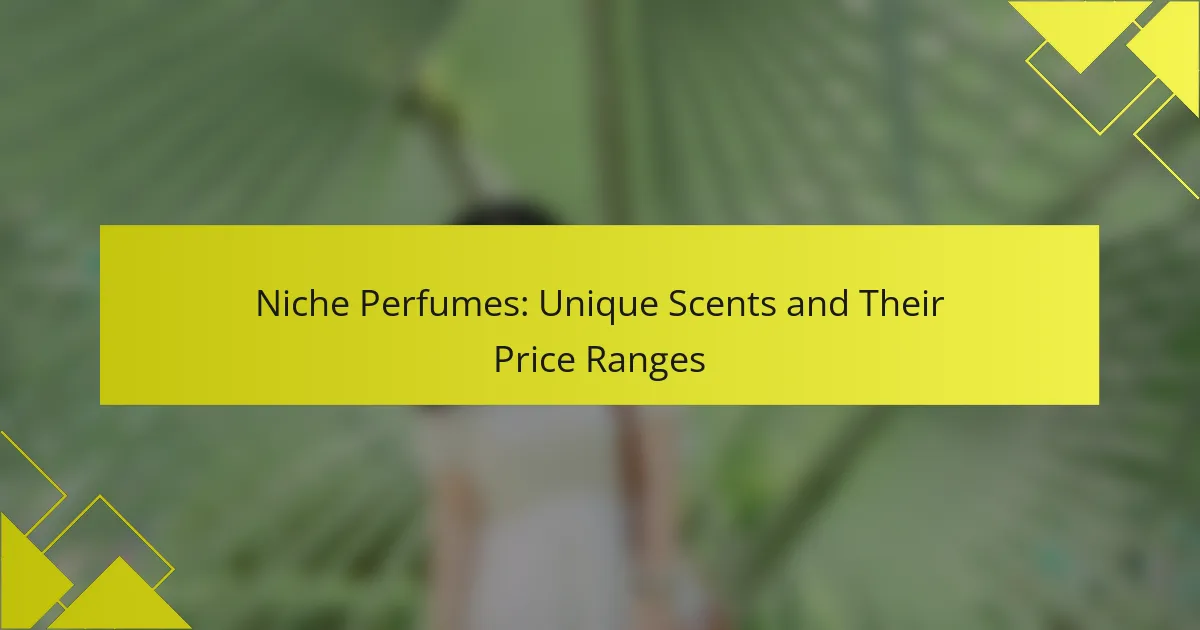
What are Designer Perfumes?
Designer perfumes are high-end fragrances created by luxury fashion brands. These perfumes often reflect the brand’s identity and aesthetic. They are typically made with premium ingredients and crafted by skilled perfumers. The quality of designer perfumes is generally higher than mass-market scents. This is due to the use of rare and natural materials. Designer perfumes also tend to have unique and complex scent profiles. They are marketed as exclusive products, often with distinctive packaging. The price of designer perfumes is usually higher, reflecting their quality and brand prestige.
How are Designer Perfumes different from other fragrances?
Designer perfumes are distinct from other fragrances primarily due to their quality, branding, and formulation. They often use higher concentrations of essential oils, resulting in richer scents. The ingredients in designer perfumes are typically sourced from premium suppliers, enhancing overall fragrance longevity. Additionally, designer brands invest significantly in research and development. This leads to unique scent profiles that are often exclusive to the brand. The packaging of designer perfumes also reflects luxury, often featuring elaborate designs. This attention to detail contributes to the overall consumer experience. According to market research, consumers are willing to pay more for designer fragrances due to perceived quality and prestige.
What defines the quality of Designer Perfumes?
The quality of designer perfumes is defined by their ingredients, craftsmanship, and brand reputation. High-quality designer perfumes often use natural essential oils and high-grade synthetic compounds. The concentration of fragrance oils also plays a crucial role; higher concentrations lead to more intense and longer-lasting scents. Craftsmanship involves the skill in blending these ingredients to create a harmonious fragrance profile.
Additionally, the reputation of the brand impacts perceived quality. Established brands often have a history of quality assurance and customer satisfaction. Packaging and presentation also contribute to the overall quality perception. Luxury packaging often signifies a premium product. Finally, the longevity and sillage of the perfume are key indicators. Quality perfumes typically last longer and project better than lower-quality alternatives.
What are the common characteristics of Designer Perfumes?
Designer perfumes typically exhibit high-quality ingredients and unique scent compositions. They often feature complex fragrance notes that evolve over time. Designer perfumes are known for their longevity and sillage, meaning they last longer and project further than mass-market fragrances. They come in aesthetically pleasing packaging that reflects the brand’s identity. Many designer perfumes are created by renowned perfumers, ensuring expert craftsmanship. Limited editions and exclusive releases are common, enhancing their appeal. The price point is generally higher due to the quality and brand prestige associated with designer labels. Overall, designer perfumes emphasize luxury, artistry, and individuality in fragrance creation.
Why do consumers choose Designer Perfumes?
Consumers choose designer perfumes for their perceived quality and prestige. Designer brands often use high-quality ingredients and craftsmanship. This results in unique and long-lasting fragrances. Consumers associate these perfumes with luxury and status. Designer perfumes often have distinct branding and packaging that attract buyers. Many consumers are influenced by advertising and celebrity endorsements. Research shows that 60% of consumers are willing to pay more for brand reputation. Ultimately, the emotional connection and experience tied to designer perfumes drive consumer choices.
What emotional or psychological factors influence the choice of Designer Perfumes?
Emotional and psychological factors significantly influence the choice of designer perfumes. Consumers often associate specific scents with memories or emotions. This connection can evoke feelings of nostalgia, happiness, or confidence. Brand identity also plays a crucial role; luxury brands often symbolize status and prestige. Additionally, personal identity and self-expression drive choices in fragrance. Individuals select scents that align with their personality or desired image. Research indicates that fragrance preferences can be linked to mood enhancement. A study published in the Journal of Sensory Studies found that pleasant scents can elevate mood and influence purchasing behavior. Thus, emotional and psychological factors are integral to the decision-making process for designer perfumes.
How does brand reputation impact consumer preferences?
Brand reputation significantly influences consumer preferences. A strong reputation builds trust and credibility with consumers. Trust leads to increased likelihood of purchase decisions. According to a study by Nielsen, 59% of consumers prefer to buy new products from familiar brands. Positive brand reputation can also justify higher prices. Consumers often associate reputable brands with quality and reliability. This connection can lead to brand loyalty over time. Brands with negative reputations may struggle to attract new customers. In the designer perfume market, reputation affects perceived value and desirability.

What factors influence the cost of Designer Perfumes?
The cost of designer perfumes is influenced by several key factors. Brand reputation plays a significant role, as established luxury brands often command higher prices. The quality of ingredients used also affects cost; rare or high-quality raw materials increase production expenses. Production methods contribute as well; artisanal or handcrafted processes typically raise the price. Packaging and marketing expenses are additional factors, as visually appealing bottles and extensive advertising campaigns add to overall costs. Finally, exclusivity can drive up prices; limited edition fragrances often come with a premium. These factors collectively determine the market price of designer perfumes.
How do ingredients affect the pricing of Designer Perfumes?
Ingredients significantly influence the pricing of designer perfumes. High-quality natural ingredients, such as rare floral extracts and essential oils, tend to be more expensive. These ingredients are often sourced from specific regions, increasing their cost due to limited availability. Synthetic ingredients, while cheaper, may not provide the same depth of scent, affecting the overall quality perception.
Additionally, the extraction and production processes for natural ingredients can be labor-intensive and time-consuming. For instance, the extraction of jasmine oil requires thousands of flowers to produce a small quantity, raising the price.
Moreover, brands often market their perfumes based on the exclusivity of their ingredients. This marketing strategy can further elevate the perceived value and price. In summary, the quality, rarity, sourcing, and production methods of ingredients are key factors that directly impact the pricing of designer perfumes.
What are the most common high-quality ingredients used?
The most common high-quality ingredients used in designer perfumes include essential oils, natural extracts, and synthetic compounds. Essential oils provide rich fragrances derived from plants. Common examples are rose oil, jasmine, and sandalwood. Natural extracts enhance the perfume with unique scents. Ingredients like vanilla and citrus oils are frequently utilized. Synthetic compounds allow for consistency and creativity in fragrance formulation. Molecules such as ambroxan and iso-e-super are popular in modern perfumery. These ingredients contribute to the overall quality and complexity of the scent. Their use is prevalent in high-end fragrances, ensuring a luxurious experience.
How do rare ingredients contribute to cost?
Rare ingredients significantly increase the cost of designer perfumes. Their scarcity limits availability, driving up market prices. For example, ingredients like oud or certain floral extracts can cost thousands of dollars per kilogram. This high cost stems from factors such as labor-intensive harvesting methods and limited geographic distribution. Additionally, the unique scent profiles of rare ingredients often justify premium pricing. Perfume brands leverage these exclusive components to enhance their product’s luxury appeal. Consequently, the presence of rare ingredients contributes to both the perceived and actual cost of designer perfumes.
What role does packaging play in the cost of Designer Perfumes?
Packaging significantly contributes to the overall cost of designer perfumes. High-quality packaging materials enhance the perceived value of the fragrance. Luxurious designs and unique bottle shapes require more investment in manufacturing. Additionally, intricate packaging may involve advanced production techniques, increasing costs. The aesthetic appeal of packaging can influence consumer purchasing decisions. Research indicates that consumers are willing to pay more for visually appealing products. Therefore, packaging plays a crucial role in both cost and marketing of designer perfumes.
How does packaging design influence consumer perception?
Packaging design significantly influences consumer perception by affecting their initial impressions and emotional responses. Attractive and innovative packaging can enhance perceived product quality. Research indicates that 70% of purchasing decisions are made at the point of sale, often driven by packaging aesthetics. For instance, designer perfumes with luxurious packaging are often perceived as more premium. This perception can justify higher price points. Studies show that consumers associate visually appealing packaging with better performance and satisfaction. Additionally, branding elements like color and typography contribute to brand recognition and loyalty. Overall, effective packaging design shapes consumer attitudes and influences buying behavior.
What are the costs associated with sustainable packaging?
The costs associated with sustainable packaging can vary significantly. Generally, sustainable packaging materials tend to be more expensive than traditional options. For instance, biodegradable plastics can cost up to 30% more than conventional plastics. Additionally, sourcing sustainable materials often involves higher transportation costs due to limited suppliers.
Labor costs may also increase, as specialized processes are required for sustainable packaging production. Furthermore, companies may incur additional expenses for certifications and compliance with environmental regulations.
According to a study by the Ellen MacArthur Foundation, transitioning to sustainable packaging could lead to a 20% increase in overall packaging costs for many businesses. This investment is often justified by the long-term benefits of brand loyalty and reduced environmental impact.

How can consumers compare quality and cost across Designer Perfume brands?
Consumers can compare quality and cost across Designer Perfume brands by analyzing fragrance notes, longevity, and price per ounce. Fragrance notes indicate the scent profile and complexity. Longevity refers to how long the scent lasts on the skin, often measured in hours. Price per ounce allows consumers to evaluate cost-effectiveness. Online platforms provide user reviews and ratings, offering insights into quality perceptions. Additionally, sampling testers in stores helps assess personal preferences. Research shows that brand reputation also influences perceived quality, affecting consumer choices.
What are the best methods for evaluating the quality of Designer Perfumes?
The best methods for evaluating the quality of designer perfumes include sensory evaluation, ingredient analysis, and brand reputation assessment. Sensory evaluation involves testing the fragrance on the skin and observing its evolution over time. This method allows users to experience the scent’s top, middle, and base notes. Ingredient analysis entails examining the composition of the perfume. High-quality perfumes typically feature natural ingredients and essential oils. Brand reputation assessment involves researching the brand’s history and customer reviews. Established brands often maintain quality standards. Additionally, comparing prices can indicate quality, as premium perfumes usually reflect higher production costs.
How can consumers assess fragrance longevity and sillage?
Consumers can assess fragrance longevity and sillage by testing the perfume on their skin. Longevity refers to how long a fragrance lasts after application. Consumers should apply the fragrance and observe how many hours it remains detectable. Sillage describes the scent trail left by the fragrance. To assess sillage, consumers can walk around and note how far the scent travels from their body.
Fragrance testers in stores can help gauge both attributes. A fragrance that lasts over six hours is often considered long-lasting. Sillage can be evaluated by asking others if they can smell the fragrance from a distance. Reviews and ratings online frequently provide insights on longevity and sillage for various perfumes.
What reviews or ratings should consumers consider?
Consumers should consider expert reviews and user ratings when evaluating designer perfumes. Expert reviews often provide in-depth analysis of scent profiles, longevity, and overall quality. User ratings offer insights into real-world experiences and satisfaction levels. Websites like Fragrantica and Sephora feature both expert and user reviews for various perfumes. Additionally, checking for awards or recognitions can indicate a perfume’s quality. For instance, perfumes that win FiFi Awards are recognized for excellence in the fragrance industry. Overall, combining expert analyses with user feedback creates a comprehensive understanding of a perfume’s value.
What are the most cost-effective Designer Perfume brands?
The most cost-effective designer perfume brands include Calvin Klein, Marc Jacobs, and Versace. Calvin Klein offers quality fragrances at accessible prices, often under $100. Marc Jacobs provides unique scents that balance quality and affordability, typically ranging from $70 to $120. Versace is known for luxurious fragrances that can be found at competitive prices, often between $80 and $150. These brands consistently receive positive reviews for their value, making them popular choices for budget-conscious consumers seeking designer quality.
How do these brands maintain quality while keeping prices lower?
Brands maintain quality while keeping prices lower by optimizing production processes. They often utilize cost-effective sourcing for raw materials without compromising on quality. Many brands invest in technology for efficient manufacturing. Bulk purchasing of ingredients also reduces costs significantly. Streamlined supply chains minimize overhead expenses. Some brands focus on direct-to-consumer sales to eliminate retailer markups. By leveraging economies of scale, they can maintain quality at lower prices. Research shows that brands employing these strategies can effectively balance quality and affordability, making designer perfumes accessible to a wider audience.
What are some examples of affordable yet high-quality Designer Perfumes?
Examples of affordable yet high-quality designer perfumes include Versace Bright Crystal, Calvin Klein CK One, and Dolce & Gabbana Light Blue. Versace Bright Crystal offers a refreshing floral scent at a competitive price point. Calvin Klein CK One is a unisex fragrance that combines citrus and green notes, known for its versatility. Dolce & Gabbana Light Blue features a blend of Sicilian lemon and apple, providing a vibrant and fresh aroma. These perfumes are well-regarded for their quality while remaining budget-friendly.
What tips can help consumers make informed decisions when purchasing Designer Perfumes?
Consumers can make informed decisions when purchasing designer perfumes by considering several key factors. First, they should research the brand’s reputation and the specific fragrance notes. Understanding the scent profile can help in selecting a perfume that aligns with personal preferences.
Second, consumers should test the perfume on their skin. Fragrances can smell different on the skin compared to a tester strip due to body chemistry.
Third, checking for authenticity is crucial. Buying from reputable retailers or directly from the brand can prevent counterfeit purchases.
Fourth, consumers should compare prices across different platforms. This helps in identifying the best deal and understanding the average market price for the desired fragrance.
Lastly, reading reviews from other customers can provide insights into the longevity and sillage of the perfume. This information is valuable for determining overall satisfaction with the product.
Designer perfumes are high-end fragrances created by luxury fashion brands, characterized by premium ingredients and unique scent profiles. This article explores the distinctions between designer perfumes and other fragrances, highlighting their quality, craftsmanship, and brand reputation. Key factors influencing the cost of designer perfumes, such as ingredient quality, packaging, and brand exclusivity, are examined alongside consumer preferences driven by emotional and psychological factors. Additionally, the article provides insights into evaluating quality and cost across various designer perfume brands, offering practical tips for informed purchasing decisions.



